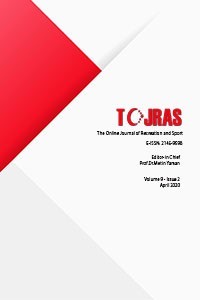5-AN ANALYSIS OF PHYSICAL EDUCATION AND SPORTS TEACHERS’ USE OF TECHNOLOGY STATES TO REACH INFORMATION
5-AN ANALYSIS OF PHYSICAL EDUCATION AND SPORTS TEACHERS’ USE OF TECHNOLOGY STATES TO REACH INFORMATION
This study aims to determine of physical education and sports teachers’ use state of tools. The research population consists of physical education and sports teachers working at middle schools in Mugla province in 2010-2011 school year. 30 physical education and sports teachers in 17 schools located in Mugla province constitute of a sample of the research. At the beginning of the study, “Technology Attitude Scale” developed by Yavuz 2005 was applied to the teachers. Later, working groups were created, and teachers were asked to carry out technology-assisted project studies. Cronbach’s alpha coefficient was calculated as 0,88. The collected data was analyzed using SPSS 14 package program. Frequency and percentage analysis were applied to determine the results. According to the analysis made, 53% stated: “Education can be given via the internet.”, 63% stated: “computers and projection devices should be used.”, 62% stated: “Technological tools have an impact on student motivation.”, 77% stated: “When certain sections of the course are recorded with a camera, it is possible to see the deficiencies and mistakes of the students.”, 87% stated: “The use of existing technology allows the development of new technologies.”, 60% stated: “ It will be easier with technology to comprehend lessons that are difficult to understand.”, 94% stated: “Students need to be given preliminary information about the use of new technologies.”, and 67% stated: “Technological tools can be successful when appealing all sensory organs.” At the end of the research, A Technology Attitude Scale was found to be significantly higher. It is thought that teachers’ use the technological materials in teaching affects the attitude scores positively
Keywords:
Technology Physical Education, Teacher, Information,
___
- Pala A. (2006). İlköğretim Birinci Kademe Öğretmenlerinin Eğitim Teknolojilerine Yönelik Tutumları, Sosyal Bilimler Dergisi, Sayı: 16
- Boydak, A. (2006). Öğrenme stilleri. İstanbul: Beyaz Yayınları
- Usun, S. (2000). Dünyada ve Türkiye de Bilgisayar Destekli Öğretim. Ankara: Pegem Yayıncılık.
- Yalın, H.D. (2003). Öğretim teknolojileri ve materyal geliştirme (8. Baskı). Ankara: Nobel Yayınları.
- Yılmaz, D. (2008). Beden eğitimi öğretmen adaylarının çeşitli değişkenler açısından İnternet kullanımına yönelik tutumlarının incelenmesi, Atatürk Üniversitesi Beden Eğitimi ve Spor Bilimleri Dergisi.2008(3), 31-38.
- Yılmaz, D. (2008). Beden eğitimi ve spor öğretim elemanlarının teknolojiye ilişkin tutumlarının değerlendirilmesi, Türkiye Sosyal Araştırmalar Dergisi. 12(1), 135–147.
- Yavuz, S. (2005). Developing a technology attitude scale for pre-service chemistry teachers. The Turkish Online Journal of Educational Technology, 4, 1–9.
- Yavuz, S ve Coşkun, A.S. (2008). Sınıf öğretmenliği öğrencilerinin eğitimde teknoloji kullanımına ilişkin tutum ve düşünceleri, Hacettepe Üniversitesi Eğitim Fakültesi Dergisi. 34, 274-286.
- Sevindik, T. (2006). “Akıllı sınıfların yüksek öğretim öğrencilerinin akademik basarı ve tutumlarına etkisi”, Yayımlanmamış doktora tezi, Fırat Üniversitesi.
- Akkoyunlu, B. (1995). Bilgi teknolojilerinin okullarda kullanımı ve öğretmenlerin rolü. Hacettepe Üniversitesi Eğitim Fakültesi Dergisi. 11, 105-109.
- ISSN: 2146-9598
- Yayın Aralığı: Yılda 4 Sayı
- Başlangıç: 2012
- Yayıncı: METİN YAMAN
Sayıdaki Diğer Makaleler
THE RELATIONSHIP BETWEEN UNIVERSITY STUDENTS’ FREE TIME MANAGEMENT AND ACADEMIC SUCCES
Emrah SERDAR, Duygu Harmandar DEMİREL, Mehmet DEMİREL, Veli Ozan ÇAKIR
ANALAZING THE EFFECTS OF PLATELET ON THE DURABILITY TRAINING
DETERMINATION OF THE PEOPLE’S SATISFACTION WHO GO TO THE ZOO FOR RECREATIONAL ACTIVITY
AN EVALUATION OF TURKISH POLICE OFFICER’S VIEW ON VIOLENCE IN FOOTBALL AND HOOLIGANISM
Ercan ZORBA, T Osman MUTLU, Akan BAYRAKDAR
ANALYSING WOMAN FOOTBALLERS^SOME PHYSICAL RATES ACCORDING TO THEIR PLAYING POSITIONS AND AGES
Kenan UZUN, Bekir MENDEŞ, Ayhan TEPE
H Nur ZORBA, Ercan ZORBA, Merve KARAMAN
ANALYZING OF THE EXCERCISE ADDICTION IN INDIVUALS ENGAGED WITH INDIDIVDUAL AND TEAM SPORTS
